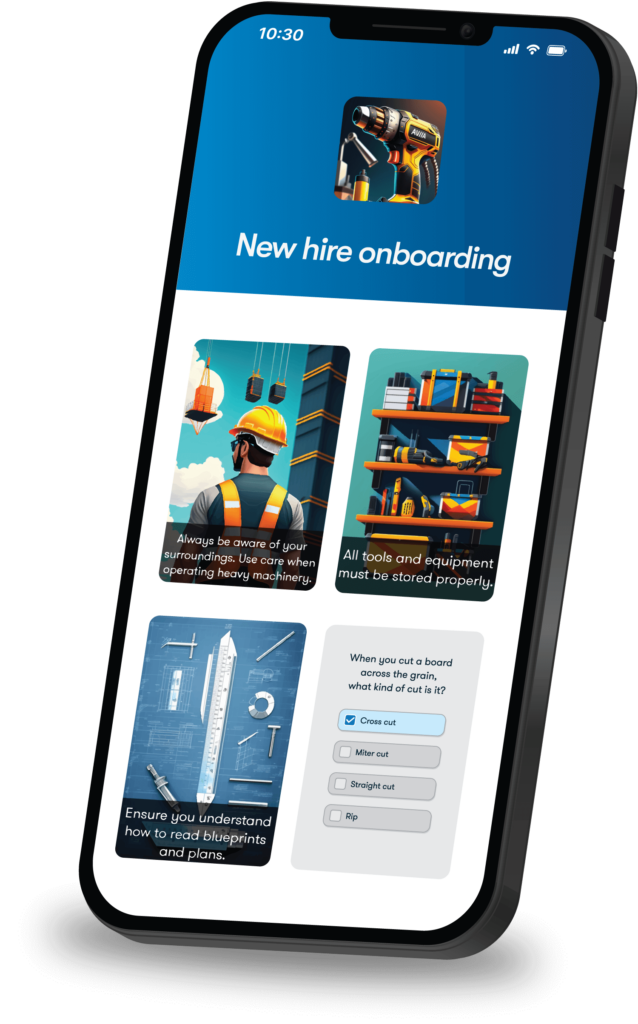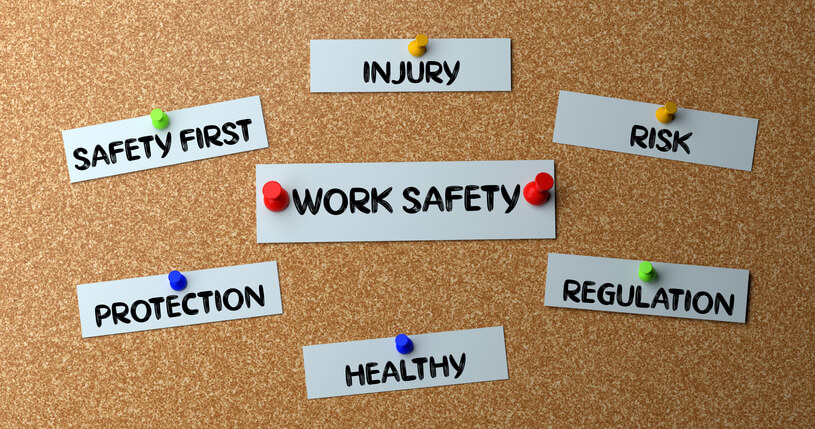In 2022, private industry employers documented 2.8 million nonfatal injuries and illnesses, according to the Bureau of Labor Statistics.
That number represents real people, and speaks to the real challenges they face in their daily work environments.
That’s why workplace safety is a critical topic for employers— they have to provide consistent and quality safety education and practices. By doing so, businesses protect their most valuable asset— their employees— and foster a culture of safety.
Committing to safety leads to a more engaged and productive workforce, while significantly reducing the negative impacts of workplace incidents.
What are safety topics for work?
Safety topics for work are a broad range of subjects that cover information meant to prevent on-the-job injury and illness. These topics vary depending on where you work, but often include general safety practices, proper personal protective equipment (PPE) use, workplace hazards, fire safety, and more.
Workplace safety topics equip employees with the knowledge and skills they need to maintain a safe work environment.
Why are safety meetings important?
Most workplace injuries aren’t unforeseen events. They can often be predicted and prevented. With this understanding, OSHA now refers to them as incidents instead of accidents.
Although this change in terminology may seem minor, it represents a shift toward proactive prevention. The focus has moved to identifying and addressing hazards before they result in injury or illness. Think of it like putting out a fire after it has caused damage and harm, versus taking measures to ensure fires never start in the first place.
In order to focus on prevention, you must strategically choose your safety topics for work. If you’ve seen an uptick in slips and falls, there might be a housekeeping issue to address. Back injuries might mean getting lifting equipment and focusing on lifting techniques training.
Your safety meeting ideas should follow a predetermined schedule while still remaining flexible enough to address pressing safety concerns quickly.
What are some safety meeting topics?
Understanding the importance of safety meetings as a preventative measure is the first step. You need to have a list of ideas at the ready.
Here’s a curated list of safety meeting topics to help you cover essentials and bolster your refresher training sessions.
General safety
These proactive discussions focus on broad safety practices.
Topics include:
1. Safe lifting and carrying techniques
2. Preventing slips, trips, and falls
3. Reporting incidents
4. Proper lighting
5. Housekeeping in common areas
Proper use of Personal Protective Equipment (PPE)
A meeting on PPE educates employees on the correct selection, usage, and maintenance of safety gear tailored to specific job hazards.
Topics include:
6. Head protection
7. Eye protection
8. Respirator maintenance
9. Face shields and goggles
10. Protective footwear
Workplace hazards
These safety meetings address identifying, assessing, and preventing potential risks.
Topics include:
11. Hazardous materials
12. Machine guarding
13. Fall prevention
14. Repetitive motion injuries
15. Weather-related hazards
Fire safety
During a fire safety meeting, staff learns about fire risks, prevention strategies, and responses to minimize harm during a fire.
Topics include:
16. Fire extinguisher use
17. Fire prevention
18. Fire drills
19. Fire safety in storage areas
20. Fire safety in kitchens and break rooms
Electrical safety
An electrical safety meeting teaches proper handling of equipment, recognizes hazards, and how to implement preventative measures.
Topics include:
21. Electrical hazards
22. Lockout/tagout procedures
23. Power tool safety
24. Working near power lines
25. Electrical safety for office equipment
Equipment and machinery safety
If your workplace involves machinery, it is important to keep your staff up to date on operation, maintenance, and safety protocols.
Topics include:
26. Forklift safety
27.Machine operation
28. Conveyor belt safety
29. Safety with hand trucks and dollies
30. Vehicle safety
Chemical safety
The goal of chemical safety meetings is to prevent accidents and exposure.
Topics include:
31. Chemical handling and storage
32. Spill response
33. PPE for chemicals
34. Chemical labeling
35. Chemical disposal
Emergency response
These meetings prepare staff to act swiftly and effectively during unforeseen incidents.
Topics include:
36. First aid procedures
37. CPR training
38. AED usage
39. Emergency response drills
40. Shelter-in-place procedures
Health and wellness
Balancing both the physical and mental challenges, and how to handle them, are the focus of these meetings.
Topics include:
41. Hydration and heat safety
42. Stress management
43. Mental health awareness
44. Mindfulness practices
45.Work-life balance
Environmental safety
Protect both the workplace and the planet with strategies to ensure a safer and more sustainable environment.
Topics include:
46. Recycling practices
47. Hazardous waste management
48. Paperless initiatives
49. Chemical spill containment
50. Reducing office waste
Workplace culture and safety
Here, the focus is the importance of collective responsibility and communication in creating a safe workplace.
Topics include:
51. Conflict prevention
52. Conflict resolution techniques
53. Mediation and third-party involvement
54. Promoting team bonding
55. Celebrating safety milestones
Remote work safety
Explore how to maintain safety, security, and wellness in a non-traditional work setting.
Topics include:
56. Digital security
57. Mental health for remote work
58. Collaboration and communication
59. Managing team performance
60. Remote meeting security
Cybersecurity and data safety
Highlight the importance of protecting sensitive information with best practices to mitigate risks and prevent breaches.
Topics include:
61. Password security
62. Data privacy and confidentiality
63. Secure file sharing
64. Mobile device security
65. File encryption best practices
Ergonomics
Take time to explore enhancing comfort and efficiency in the workplace.
Topics include:
66. Proper lifting techniques
67. Proper lighting to reduce eye strain
68. Supportive seating
69. Ambient noise reduction
70. Adjustable desk height
Heat/extreme weather conditions
Navigate the risks of working in high temperatures using strategies and best practices.
Topics include:
71. Recognizing heat-related illness
72. Hydration and nutrition
73. Work-rest cycles
74. Appropriate clothing and PPE
75. Emergency response to heat illness
Choosing a safety topic of the day
Sometimes, despite your best efforts to plan, days become unpredictable. When time is short, you might find yourself asking, “What is a good safety message for today?”
Instead of skipping your crucial safety meeting, you can rely on some short safety topics for work. The concept of toolbox talks is perfect in this situation.
Toolbox talks are short, informal meetings focused on specific safety topics designed to be engaging and to the point. They serve as a quick and effective way to address safety concerns, reinforce safe practices, and ensure safety is at the front of everyone’s minds.
Harnessing mobile training platforms for safety education
Using a mobile training platform to cover workplace safety topics is a game-changing way to put info in the palm of your employees’ hands, without interrupting their work day.
Here’s how a mobile platform can help:
- Access to safety training anytime, anywhere
A mobile training app means your staff has instant access to safety information, including offline. They can review information as they need it, and stay up to date on all training initiatives.
- Quick safety updates
When there’s something new to learn, or a critical update you need to communicate, a mobile training app allows you to simply send out a push notification to everyone’s phones. The need for coordinating schedules and resources is eliminated, and you’ve avoided blasting out one more email that is left unread.
- Gamified and interactive learning
Mobile training apps empower you to teach safety topics in gamified ways that lead to better memory retention: card sets, quizzes, badges, challenges, points, and many more interactive elements.
- Trackable learning
From an administrative point of view, it’s critical that you have detailed, data-driven insights into your employees’ safety training. Choose a platform that tracks when employees start and complete their training, how long it takes, and how well they perform on assessments.
Using a mobile app for safety training makes it easier for everyone to learn important safety information in a way that fits into their busy days.
Make safety guides accessible anywhere with a powerful mobile training app

FAQs
What is a good safety message for today?
A “good” safety message for today is one that is relevant to the industry you’re in, and the specific employees you’d like to address. Some universally good messages are:
- Always be aware of fire exits and where extinguishers are located in the event of an emergency.
- Keep safety exits clear at all times.
- Be sure to tape down cables and cords to prevent trips in the workplace.
What are safety topics for employees?
Safety topics for employees cover a wide range of topics. They aim to prevent accidents and ensure a safe work environment. These can include general safety practices, proper use of PPE, fire safety, and more. Each topic addresses specific risks and gives employees the knowledge and tools they need to work safely.
What are 10 tips for work safety?
Ten essential tips for work safety are:
- Always follow proper operating procedures when using machinery and tools.
- Take regular breaks to avoid fatigue and mistakes.
- Report hazardous conditions to management right away.
- Know your exit strategy in the event of an emergency.
- Never operate machinery under the influence of drugs or alcohol.
- Wear PPE.
- Practice mindfulness and minimize stress.
- Never take shortcuts on procedures.
- Prioritize ergonomics to preserve your health.
- Stay up to date on new safety procedures.
What is a good safety topic for September?
September is National Food Safety Education Month, which emphasizes the importance of preventing foodborne illnesses in the workplace.
Some topics that go along with this are:
- Food hazards and risks
- Handwashing
- Safe food preparation
- On-site food safety
Create safety training your employees can access from anywhere with TalentCards



